Sealing stained concrete is an important step in maintaining its appearance and durability. It helps protect the surface from stains, scratches, and other damage caused by regular use and exposure to various elements like water, chemicals, and UV rays. Additionally, a properly sealed stained concrete surface will have a beautiful glossy finish that enhances its natural colors and patterns.
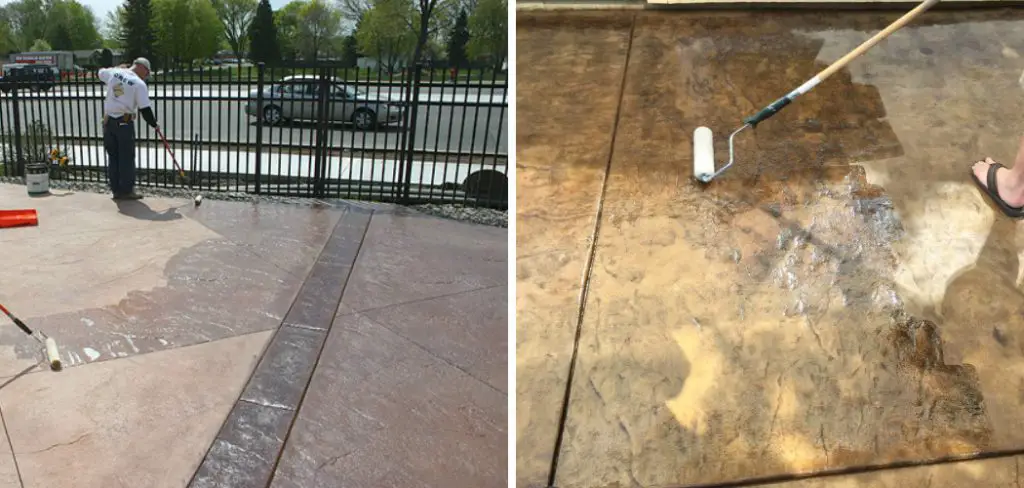
The main advantage of sealing stained concrete is to protect it from damage caused by exposure to the elements, foot traffic, and stains. The sealer acts as a barrier between the concrete surface and potential damaging factors. In this blog post, You will learn in detail how to seal stained concrete.
Step by Step Processes for How to Seal Stained Concrete
Step 1: Inspect the Concrete Surface
Before you begin the sealing process, it is important to inspect your stained concrete surface. Look for any cracks or damage that may have occurred over time. If there are any major repairs needed, it is best to address them before proceeding with the sealing process.
Step 2: Clean the Surface
Next, thoroughly clean the entire stained concrete surface using a pressure washer or a stiff-bristled brush. Make sure to remove any dirt, debris, or stains that may be present on the surface. This will ensure proper adhesion of the sealant.
Step 3: Remove Any Existing Sealant
If there is already an existing sealant on your stained concrete, it is important to remove it before applying a new one. You can use a chemical stripper or a mechanical sander to remove the old sealant. Make sure to follow the manufacturer’s instructions carefully.
Step 4: Allow the Surface to Dry
After cleaning and removing any existing sealant, it is crucial to allow the surface to completely dry before applying a new sealant. This will ensure that the sealant properly adheres to the concrete surface.
There are various types of sealants available in the market, such as acrylic, epoxy, and polyurethane. Each type has its own advantages and disadvantages. It is important to choose the right sealant for your specific stained concrete surface based on factors like durability, appearance, and maintenance requirements.
Step 5: Test the Sealant on a Small Area
Before applying the sealant on the entire surface, it is recommended to do a test patch on a small, inconspicuous area of the stained concrete. This will help you determine if the sealant is compatible and gives desired results.
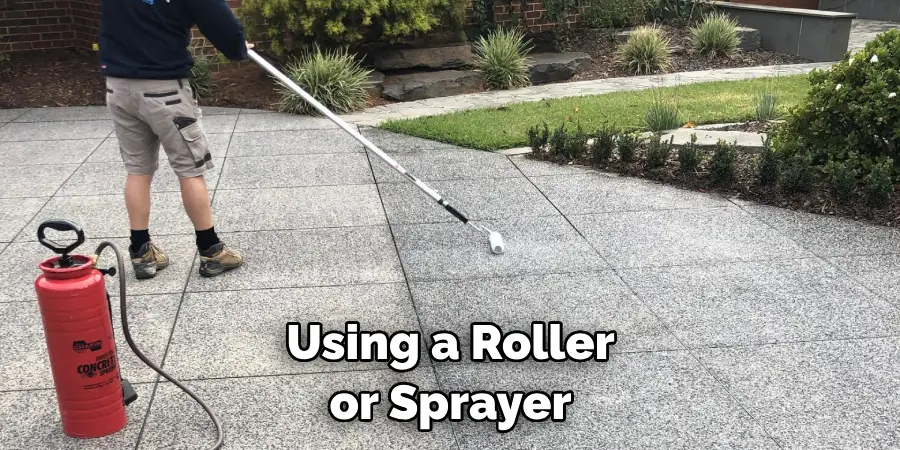
Using a roller or sprayer, apply the sealant evenly on the stained concrete surface. Make sure to follow the manufacturer’s instructions and apply multiple thin coats rather than one thick coat for better results.
Step 6: Allow the sealant to dry
After applying the sealant, it is important to allow it to dry completely before walking or placing any objects on the surface. This can take anywhere from a few hours to a full day, depending on the type and brand of sealant used.
For added protection and durability, you may choose to apply a second coat of sealant once the first coat has completely dried. This will also enhance the appearance of your stained concrete surface.
Step 7: Maintain the Sealed Surface
To ensure the longevity of your sealed stained concrete surface, it is important to properly maintain it. This includes regular cleaning with a mild detergent and reapplying the sealant every few years depending on foot traffic and wear.
By following these step by step processes, you can effectively seal your stained concrete surface and protect it from damage, stains, and wear. Remember to choose the right sealant for your specific needs and to properly maintain the sealed surface for long-lasting results. With proper care, your stained concrete will continue to enhance the beauty of your space for years to come.
7 Safety Tips for How to Seal Stained Concrete
- When working with sealants, always wear protective gear such as gloves, safety glasses, and a respirator to avoid any splashes or fumes.
- Keep the work area well-ventilated by opening windows and doors to prevent inhaling harmful chemicals.
- Do not smoke or light any flames in the vicinity of the sealant, as it is highly flammable.
- Use caution when working on concrete surfaces, as they can become slippery when wet.
- Read and follow the instructions provided by the manufacturer carefully to ensure proper usage and application of the sealant.
- Keep children and pets away from the work area to prevent any accidental exposure to the sealant.
- Properly dispose of any leftover sealant, brushes or rags according to local regulations.
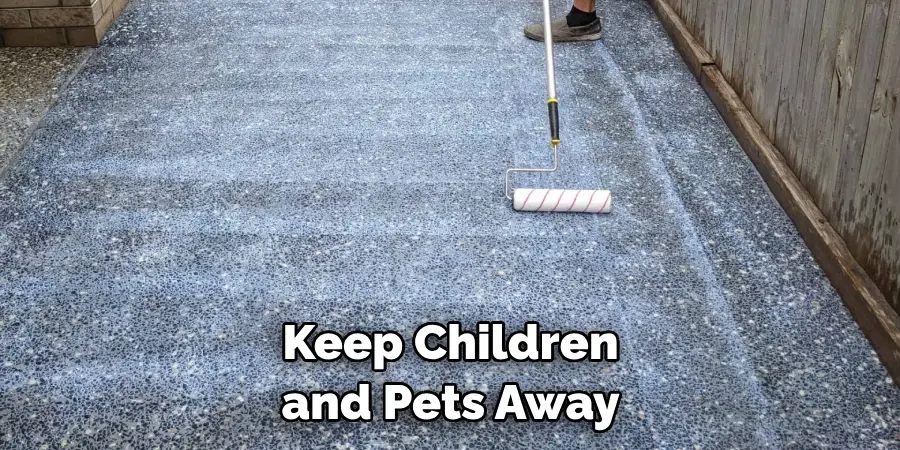
By following these safety tips, you can successfully seal your stained concrete without any accidents or mishaps. Remember to always prioritize your safety and take the necessary precautions when working with sealants. Now let’s move on to the steps for sealing stained concrete.
How Do You Properly Clean and Prepare Your Stained Concrete Before Sealing?
Stained concrete is a popular flooring option due to its durability and affordability. However, in order to maintain its appearance and longevity, it is important to properly seal the stained concrete. In this section, we will discuss how to clean and prepare your stained concrete before sealing.
1. Sweep and Vacuum
Before you start cleaning your stained concrete, make sure to sweep or vacuum the area to remove any loose dirt or debris. This will prevent them from getting stuck in the cleaning solution and potentially scratching the surface of the concrete during the cleaning process.
2. Use a pH-neutral Cleaner
When it comes to choosing a cleaner for your stained concrete, it is important to use a pH-neutral cleaner. Avoid using harsh chemicals such as bleach or ammonia as they can damage the stain and discolor the concrete. Instead, opt for a cleaner specifically designed for stained concrete or a mild dish soap.
3. Scrub with a Soft-Bristled Brush
Once you have your cleaning solution ready, use a soft-bristled brush to scrub the stained concrete. This will help loosen any dirt or stains without causing damage to the surface. Avoid using a wire brush or any abrasive cleaning tools as they can leave scratches on the concrete.
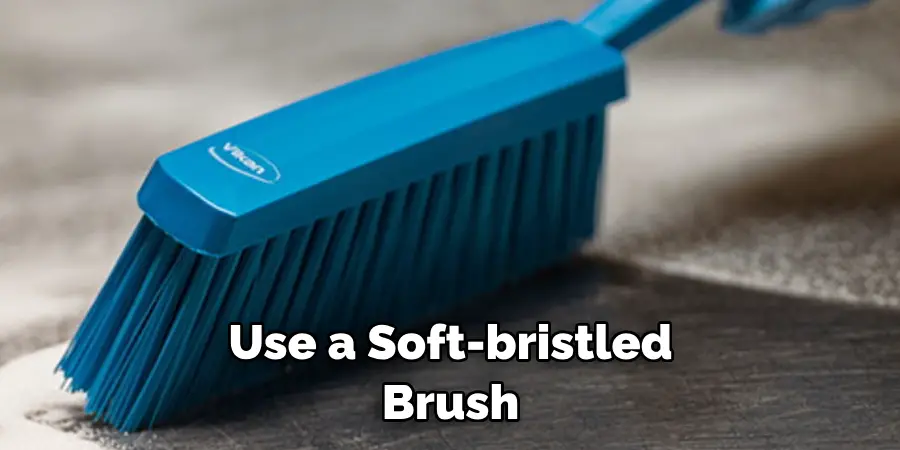
4. Rinse Thoroughly
After scrubbing, rinse the stained concrete thoroughly with clean water to remove any remaining cleaner and dirt. You can use a mop or a wet/dry vac for this step.
5. Allow to Dry Completely
Before sealing, make sure the stained concrete is completely dry. Moisture can interfere with the sealant’s ability to properly adhere to the concrete surface. It is recommended to wait at least 24 hours before proceeding to the next step.
6. Remove Any Residue or Streaks
Sometimes, after cleaning and drying, you may notice residue or streaks on the stained concrete. This can be due to the cleaning solution or water not being completely removed. In this case, use a clean, dry cloth to buff out any streaks and remove residue.
7. Apply the Sealant
Now it’s time to seal your stained concrete! Choose a high-quality sealant that is specifically designed for stained concrete. Using a roller or brush, apply a thin, even coat of sealant on the concrete surface. Make sure to cover all areas and avoid over-applying.
8. Let it Dry
Once you have applied the sealant, let it dry completely according to the manufacturer’s instructions. This can take anywhere from 24-48 hours depending on the type of sealant used.
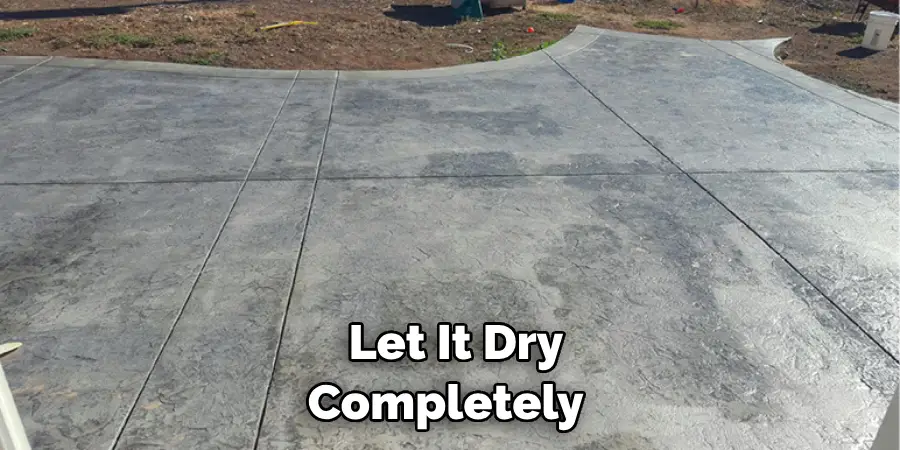
9. Apply a Second Coat (Optional)
If desired, you can apply a second coat of sealant for added protection. Make sure to let the first coat dry completely before applying the second coat.
10. Maintain Regularly
After sealing your stained concrete, it is important to maintain it regularly. This includes sweeping and mopping regularly and avoiding harsh chemicals or abrasive cleaning tools. With proper maintenance, your stained concrete will remain beautiful and protected for years to come.
By following these steps on how to properly clean and prepare your stained concrete before sealing, you can ensure a long-lasting and well-protected floor. Remember to choose the right cleaning products and sealant, let the concrete dry completely, and maintain it regularly to keep your stained concrete looking its best.
What Are Some Common Mistakes to Avoid When Sealing Stained Concrete?
While sealing stained concrete may seem like a straightforward process, there are some common mistakes that should be avoided to ensure the best results.
1. Not Properly Cleaning and Preparing the Concrete Beforehand
As mentioned earlier, it is important to thoroughly clean and prepare the stained concrete before applying sealant. Skipping this step can result in an uneven application or poor adhesion of the sealant.
2. Using the Wrong Type of Sealant
Not all sealants are suitable for stained concrete. It is important to choose a high-quality sealant specifically designed for this type of flooring to ensure proper protection and longevity.

3. Over-applying Sealant
Applying too much sealant can lead to a cloudy or hazy appearance on the surface of the stained concrete. It is important to follow the manufacturer’s instructions and apply a thin, even coat.
4. Not Allowing Enough Drying Time
Properly drying between coats and after the final application is crucial for the sealant to properly adhere and protect the stained concrete. Rushing this step can result in a weaker seal and potential damage.
5. Neglecting Regular Maintenance
After sealing your stained concrete, it is important to continue regular maintenance such as sweeping and mopping to keep the surface clean and free of dirt or debris. Neglecting this can lead to a build-up of grime and potentially damage the sealant over time.
By avoiding these common mistakes, you can ensure a successful sealing process for your stained concrete. Remember to follow all instructions carefully and properly maintain your sealed stained concrete for long-lasting protection.
Conclusion
In conclusion, sealing stained concrete is a crucial step in maintaining the beauty and durability of your concrete surfaces. Not only does it protect them from stains, water damage, and wear and tear, but it also enhances their appearance by adding a glossy finish. When it comes to sealing stained concrete, there are several factors to consider. First and foremost, you need to choose the right type of sealer for your specific concrete surface.
This can be either a penetrating sealer or a topical sealer, each with its own benefits and drawbacks. Next, it’s important to properly prepare the surface before sealing. This includes thoroughly cleaning the stained concrete and allowing it to dry completely. Any existing stains or damage should also be addressed before applying the sealer.
I hope this article has been beneficial for learning how to seal stained concrete. Make Sure the precautionary measures are followed chronologically.
